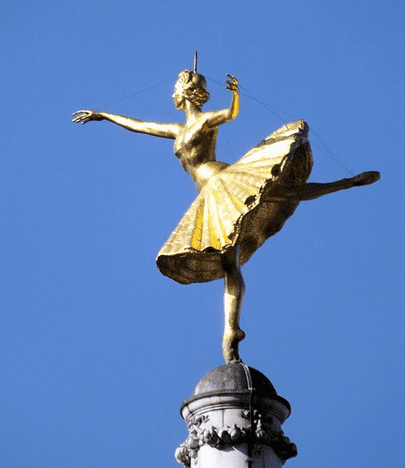#NationalDanceDay: Anna Pavlova
Headline Date 03-07-2018

National Dance Day on July 28th is rapidly pirouetting towards us, so it’s fitting to commemorate Anna Pavlova, one of the most famous dancers of all time, whose gilded statue – in arabesque stance – graces Victoria Palace Theatre.
The current statue, built in 2006 when Hary Franchetti was commissioned to reconstruct it, is a replica of the original commissioned in 1912 by Alfred Butt, producer of many of Anna Pavlova’s performances. Although the original statue was lost during the Second World War when it was removed to prevent damage during air raids, it was only replaced decades later. But when the statue was first revealed, Anna Pavlova refused to open the ceremony. She so disliked the effigy that she would even close the curtains of her car when driving past.
Anna Pavlova was a Russian prima ballerina of the late 19th and early 20th centuries, whose tutu was the inspiration for the eponymous dessert. The first ballerina to tour ballet around the globe, she gained fame for her role in Mikhail Fokine’s The Dying Swan, which she performed over 4,000 times and helped choreograph.
Captivated by the art of ballet from a young age, Anna Pavlova auditioned for the Imperial Ballet School when she was just 9 years old. After being rejected on account of her pallid complexion, she auditioned again at the age of 10 and was accepted. However, Anna was not naturally suited to the physical demands of ballet. Cursed with severely arched feet, thin ankles, and long limbs, she was teased by her classmates with malicious nicknames, such as ‘The Broom’ and La petite sauvage (The little savage). Despite these hardships, Pavlova trained relentlessly to improve her technique, eventually breaking her way into Ekaterina Vazem’s classe de perfection in 1898, and graduating as a coryphée the following year.
Pavlova swiftly gained critical acclaim, rising from the rank of danseuse in 1902 to prima ballerina in 1906, yet she never managed to escape her physical ‘imperfections’. Instead she danced in such a way that played to her strengths, setting aside the more rigid, technical styles of her contemporaries in favour of a style more suited to her weaker ankles and longer limbs. This delicate technique gained the affection of audiences (allowing her to upstage fellow ballerina Mathilde Kschessinska), captivated by the frailty and fragility of her performance.
Following her world tour a few years later, Anna Pavlova chose Golders Green, London, as her permanent place of residence. However, she continued to travel the world performing ballet. She passed away in 1931 and was cremated, her ashes now residing in the Golders Green crematorium. Ever the performer, wholly committed to her art, Anna declared, “If I can’t dance then I’d rather be dead”, and her last words, proudly and bravely uttered while rising from her deathbed, were “Get my swan suit ready”
Back to our news Top
